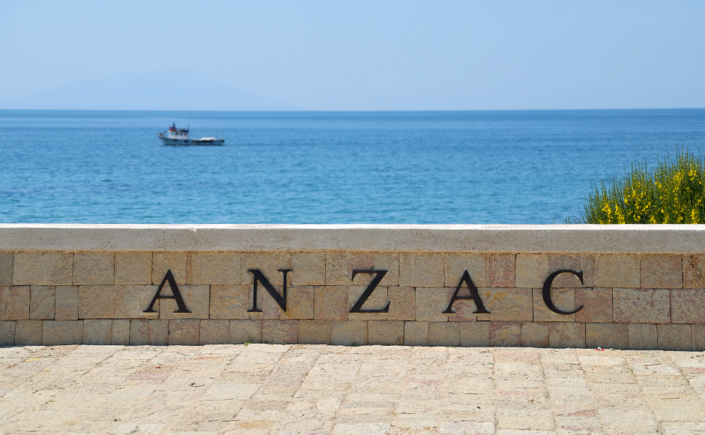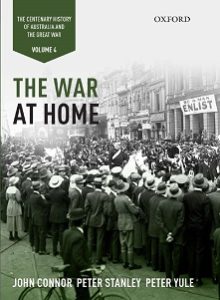Excerpt from The War at Home by John Connor, Peter Stanley and Peter Yule
‘Anzac’ (soon transmuting from acronym to word) came to sum up the Australian desire to reflect on what the war had meant. What was the first Anzac Day? At least four explanations exist for the origins of the idea of Anzac, the most enduring legacy of Australia’s Great War. Academic Gareth Knapman has shown that Adelaide held an Anzac day’ on 15 October 1915, a renaming of the traditional eight-hours festival. Author Eric Andrews dubbed the seemingly ‘spontaneous’ ceremonies held in Cairo and London on 25 April 1916 ‘a propaganda triumph’.
Early in 1916 the Bulletin urged the government to ‘take out patent rights for the name “Anzac”’. Unless it did, the name would be used by ‘every quack and dead-beat from Port Darwin to Stewart Island, foreseeing Anzac tearooms, potatoes and pills’. After the war, it hoped, Australians would ‘hold its name only in our songs and traditions’. By 1917, Anzac Day had become established as a major fund-raising day. Sydney’s George Street became ‘a live antbed’ with all of those trying to get into the free concert in the Town Hall, with 3000 people – twice its capacity – trying to get in. At the ecumenical service earlier that day the wife of the Governor-General, Lady Helen Munro Ferguson, dressed in mourning garb as ‘a tribute to the dead of Gallipoli’ and a reminder that Anzac Day at first had no connotation beyond the Dardanelles.
On the first anniversary of the invasion of Gallipoli the Bulletin’s Red Page ran the products of a competition for ‘The Anzac Sonnet’. Although the judges found many ‘fatally flawed by technical errors’ (such gaffes as rhyming ‘saw’ with ‘war’), they demonstrated that at the time the identification of Gallipoli with, as Bill Gammage later put it, ‘nationhood, brotherhood and sacrifice’ had already begun. The journalist Guy Innes, despite the solecism of using the awkward ‘withnesseth’, wrote of the Anzacs being ‘baptised by fire’ who ‘made fair Australia’s honour with their dying breath’. The winner of the competition, Bartlett Adamson, expressed the essence of Anzac:
And Anzac now is an enchanted shore;
A tragic splendour, and a holy name;
A deed eternity will still acclaim;
A loss that crowns the victories of yore …
In 1915, enough babies to fill a crèche were christened ‘Anzac’, although the Protection of Anzac regulations curtailed that, and prevented bereaved mothers naming houses after the place where their sons died. ‘Mother of One’ objected that ‘we’ve got into the way of calling the little pet “Anzay” [sic]’ and, wondering whether to use his second name, ‘Pozieres’, concluded: ‘I tell you what, I wish the old war had never started!’ No doubt it was a sentiment widely shared.
To whom did the war now belong? A century on, the rhetoric of official commemoration would assert that ‘all Australians’ shared in the pain and the pride. The contemporary record suggests that just as the experience and sacrifices of war were unevenly distributed, so its memory was felt more in some than others. Anzac Day – the ‘Diggers’ Day’ – developed through the advocacy of returned soldiers’ organisations, and through the energy of several influential figures, notably Canon David Garland, whose formula of light Christian symbolism found a ready acceptance among those with most cause to want to recall the sacrifices and comradeship of wartime. In a deeply sectarian society Catholics long remained largely excluded from civic rituals, but Anzac comradeship extended beyond the liturgical, most characteristically expressed by the late 1920s. In the capital cities huge, mostly silent crowds – 80000 in Sydney in 1928 – watched columns of returned men – perhaps 15000 of them – marching to reunions and commemorative gatherings. By 1930, aided by the introduction of the microphone and the wireless, the ‘dawn service’ had become established as the uniform commencement to a morning of solemn remembrance, albeit one typically shared in the privacy of a living room.
Although the war intruded into homes and communities, the dead lay in graves and (for about a third of them on battlefields) far away. Almost no Australian parents were granted the opportunity to mourn at their dead son’s graveside, ‘a crucial condition of wartime loss’ for Australians, Bart Ziino judges. (The exceptions were those who died lingering and often painful deaths in hospitals at home or who died post-war.) Comrades, brothers, chaplains, units and ultimately the war graves authorities went to considerable trouble to send to families depictions and descriptions of, as a booklet put it Where the Australians Rest. This brought a measure of consolation; perhaps as much as they expected.


Leave a Reply